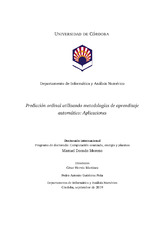Mostrar el registro sencillo del ítem
Ordinal Prediction using machine learning methodologies: Applications
| dc.contributor.advisor | Hervás-Martínez, César | |
| dc.contributor.advisor | Gutiérrez, Pedro A. | |
| dc.contributor.author | Dorado Moreno, Manuel | |
| dc.date.accessioned | 2019-12-05T09:57:31Z | |
| dc.date.available | 2019-12-05T09:57:31Z | |
| dc.date.issued | 2019 | |
| dc.identifier.uri | http://hdl.handle.net/10396/19176 | |
| dc.description.abstract | Artificial Intelligence is part of our everyday life, not only as consumers but also in most of the productive areas since companies can optimize most of their processes with all the different tools that it can provide. There is one topic that has been especially useful in the artificial intelligence implementation process which is machine learning, as it can be used in most of the practical applications that appear in real-life problems. Machine learning is the part of artificial intelligence that focuses on developing models that are able to learn a function that transforms input data into a desired output. One of the most important parts in machine learning is the model, and one of the most successful models in the state-of-the-art approaches is the artificial neural network. This is why the current thesis, for its first challenge, will study how to improve them to be able to learn more complex problems without needing to apply computationally costly training algorithms. The next important step to improve the model’s performance is to optimize the algorithms that are used to let them learn how to transform the inputs into the desired outputs, and the second challenge of this thesis is to optimize the computational cost of evolutionary algorithms, which are one of the best options to optimize ANNs due to their flexibility when training them. Ordinal classification (also known as ordinal regression) is an area of machine learning that can be applied to many real-life problems since it takes into account the order of the classes, which is an important fact in many real-life problems. In the area of social sciences, we will study how potential countries are helping the poorer ones the most, and then we will perform a deeper study to classify the level of globalisation of a country. These studies will be performed by applying the models and algorithms that were developed in the first stage of the thesis. After these first works, continuing with the ordinal classification approaches, we focused on the area of medicine, where there are many examples of applications of these techniques, e.g., any disease that may have progression is usually classified in different stages depending on its severity from low to high. In our case, this thesis will study how a treatment (liver transplantation) can affect different patients (survival time of the graft), and therefore decide which patient is the most appropriate for that specific treatment. The last chapter of the thesis will delve in ordinal classification to achieve ordinal prediction of time series. Time series have been usually processed with classical statistical techniques since machine learning models that focused on time series were too costly. However, currently, with the arrival of powerful computation machines together with the evolution of models such as recurrent neural networks, classic statistical techniques can hardly be competitive versus machine learning. In areas such as economics, social sciences, meteorology or medicine, time series are the main source of information, and they need to be correctly processed to be useful. The most common consideration when dealing with time series is to learn from past values to predict future ones, and the works in this last chapter will focus on performing ordinal predictions of WPREs in wind farms, creating novel models and methodologies. The thesis will conclude with a work that implements a deep neural network to predict WPREs in multiple wind farms at the same time; therefore, this model would allow predicting WPREs in a global area instead of in a specific geographical point. | es_ES |
| dc.format.mimetype | application/pdf | es_ES |
| dc.language.iso | eng | es_ES |
| dc.publisher | Universidad de Córdoba, UCOPress | es_ES |
| dc.rights | https://creativecommons.org/licenses/by-nc-nd/4.0/ | es_ES |
| dc.subject | Artificial intelligence | es_ES |
| dc.subject | Machine learning | es_ES |
| dc.subject | Artificial neural network | es_ES |
| dc.subject | Ordinal classification | es_ES |
| dc.subject | Imbalanced classification | es_ES |
| dc.subject | Ordinal prediction | es_ES |
| dc.subject | Time series | es_ES |
| dc.title | Ordinal Prediction using machine learning methodologies: Applications | es_ES |
| dc.title.alternative | Predicción ordinal utilizando metodologías de aprendizaje automático: Aplicaciones | es_ES |
| dc.type | info:eu-repo/semantics/doctoralThesis | es_ES |
| dc.relation.projectID | Gobierno de España. TIN2014-54583-C2-1-R | es_ES |
| dc.relation.projectID | Gobierno de España. TIN2017-85887-C2-1-P | es_ES |
| dc.rights.accessRights | info:eu-repo/semantics/openAccess | es_ES |

